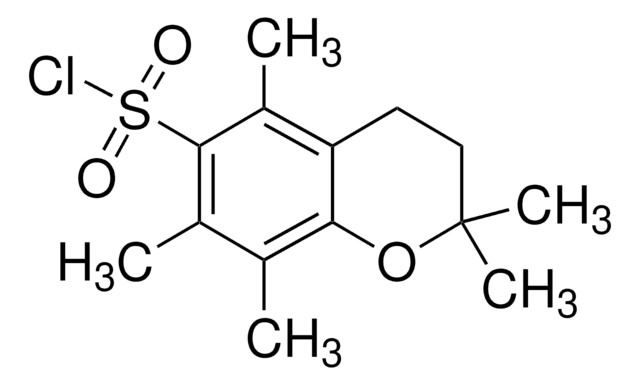8.52034
Fmoc-Arg(Pmc)-OH
Novabiochem®
Synonim(y):
Fmoc-Arg(Pmc)-OH, N-α-Fmoc-N G-(2,2,5,7,8-pentamethylchroman-6-sulfonyl)-L-arginine
About This Item
Polecane produkty
Poziom jakości
linia produktu
Novabiochem®
Próba
≥85.0% (acidimetric)
≥98% (TLC)
≥98.0% (HPLC)
Postać
powder
przydatność reakcji
reaction type: Fmoc solid-phase peptide synthesis
producent / nazwa handlowa
Novabiochem®
mp
70-120 °C (decomposition)
Zastosowanie
peptide synthesis
grupa funkcyjna
amine
temp. przechowywania
15-25°C
InChI
1S/C35H42N4O7S/c1-20-21(2)31(22(3)23-16-17-35(4,5)46-30(20)23)47(43,44)39-33(36)37-18-10-15-29(32(40)41)38-34(42)45-19-28-26-13-8-6-11-24(26)25-12-7-9-14-27(25)28/h6-9,11-14,28-29H,10,15-19H2,1-5H3,(H,38,42)(H,40,41)(H3,36,37,39)/t29-/m0/s1
Klucz InChI
QTWZCODKTSUZJN-LJAQVGFWSA-N
Opis ogólny
Associated Protocols and Technical Articles
Cleavage and Deprotection Protocols for Fmoc SPPS
Literature references
[1] R. Ramage, et al. (1987) Tetrahedron Lett., 28, 2287.
[2] J. Green, et al. (1988) Tetrahedron Lett., 29, 4341.
[3] R. Ramage, et al. (1991) Tetrahedron Lett., 47, 6353.
[4] P. Sieber (1987) Tetrahedron Lett., 28, 1637.
[5] C. G. Fields, et al. (1993) Tetrahedron Lett., 34, 6661.
[6] H. Choi, et al. (1993) Int. J. Peptide Protein Res., 42, 58.
[7] A. Stierandova, et al. (1994) Int. J. Peptide Protein Res., 43, 31.
[8] P. M. Fischer, et al. (1992) Int. J. Peptide Protein Res., 40, 19.
[9] S. A. G. Beck, et al. (1991) Int. J. Peptide Protein Res., 38, 25.
[10] E. Jaeger, et al. (1993) Biol. Chem. Hoppe-Seyler, 374, 349.
[11] P. White in ′Peptides, Chemistry & Biology, Proc. 12th American Peptide Symposium′, J. A. Smith & J. E. Rivier (Eds), ESCOM, Leiden, 1992, pp. 537.
Powiązanie
Komentarz do analizy
Appearance of substance (visual): powder
Identity (IR): passes test
Enantiomeric purity: ≥ 99.5 % (a/a)
Purity (TLC(011C)): ≥ 98 %
Purity (TLC(157B)): ≥ 98 %
Assay (HPLC, area%): ≥ 98.0 % (a/a)
Solubility (12,5 mmol in 25 ml DMF): clearly soluble
Assay (acidimetric): ≥ 85.0 %
Water (K. F.): ≤ 1.50 %
To see the solvent systems used for TLC of Novabiochem® products please click here.
Informacje prawne
Kod klasy składowania
11 - Combustible Solids
Klasa zagrożenia wodnego (WGK)
WGK 3
Temperatura zapłonu (°F)
Not applicable
Temperatura zapłonu (°C)
Not applicable
Certyfikaty analizy (CoA)
Poszukaj Certyfikaty analizy (CoA), wpisując numer partii/serii produktów. Numery serii i partii można znaleźć na etykiecie produktu po słowach „seria” lub „partia”.
Masz już ten produkt?
Dokumenty związane z niedawno zakupionymi produktami zostały zamieszczone w Bibliotece dokumentów.
Nasz zespół naukowców ma doświadczenie we wszystkich obszarach badań, w tym w naukach przyrodniczych, materiałoznawstwie, syntezie chemicznej, chromatografii, analityce i wielu innych dziedzinach.
Skontaktuj się z zespołem ds. pomocy technicznej








